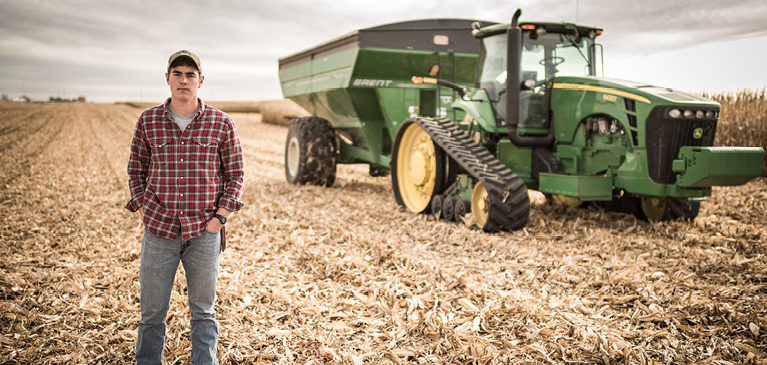
In some industries, new professionals might sit in a cubicle, draw a salary and let others figure out how to run a profitable business. In farming, however, new producers must figure out why they want to work long hours in fields, pastures or feedlots, how they can turn that effort into a steady income, and what type of farm operation they can successfully operate from one year to the next.
Not surprisingly, that type of grit and determination can make a big difference with agricultural lenders. While passion is clearly a major prerequisite for farm life, capital is also vital for young or beginning producers trying to get started in an expensive business. Due in large part to steep entry barriers, such as high prices for purchasing or renting land, substantial input costs, and depressed returns on farm commodities, fewer than 8 percent of U.S. producers are under age 35.
While many grew up on farms that became a launching pad for their own operations, it's still common for younger producers to hold down second jobs to help finance their dreams of rural life, as reported in Successful Farming September 2015. When facing those hurdles, experts say it's important that young producers–or even older individuals ones, are ready to answer tough questions and have a plan prepared.
Develop a Business Plan
Business plans are a routine part of the financing process for virtually any business. However, 63 percent of current producers who participated in a recent Sustainable Agriculture Research and Education survey said they had no formal business plan when they started farming. That lapse may help explain why a majority of respondents also said they were "not very successful" at maintaining profitability, managing expenses, and insuring their operations.
In essence, the business plan outlines a strategic overview of what a beginning or young producer wants to accomplish, and why they are a good candidate for achieving those goals. If done well, the plan should include:
Personal narrative
This should include a personal and educational history, an outline of farming experience and a discussion of why the producer wants to pursue a career on the land.
Business overview
In this section, producers should start by identifying their target business model, such as a partnership, limited liability company or other entity for tax purposes. Then, outline short-term goals that cover the intended type of operation (such as crop, livestock or organic farming, or a community-supported agriculture enterprise serving a more urban area). These goals should provide specific targets on production, anticipated income and planned expenses. This overview becomes even stronger if the producer takes time to illustrate longer-term projections on how the farm business can grow while maintaining profitability.
Risk management approach
This component should summarize the producer's approach to handling the uncertainties of farm life. For a production crop operation, this may include the choice of Agricultural Risk Coverage (ARC) or Price Loss Coverage (PLC) under the 2014 Farm Bill, the use of any private multi-peril crop insurance, and a discussion of how the producer would use crop marketing tools to hedge profit risk in the current low commodity price environment. In addition, this risk management narrative should also address contingency planning, which is an important reality-check that all lenders want to see.
Balance sheet
Experienced producers have years of income and cash-flow statements, equity statements, expense records and cost-of-production data. On the other hand, the financial records for most young or beginning farmers often boil down to a basic balance sheet. Lenders will want to see a list of current assets, such as checking, savings and any investment account balances, as well as the value of any real property or vehicles owned by the prospective borrower.On the liability side, the balance sheet should disclose any outstanding debt on a mortgage, vehicle, student loans or credit cards, and any regular monthly payments on those obligations. In addition, lenders typically want to review up to three years of the applicant's most recent tax returns.
The balance sheet summary serves two main purposes. First, it provides lenders with a tangible sense of how well applicants handle their financial affairs (and, by extension, how likely they are to repay operating loans). And, the balance sheet will also determine whether the applicant meets minimum capital standards for lender financing. Across the Farm Credit System, lending to young or beginning producers typically includes a review of the borrower's net worth, ownership equity in the planned farm operation, and expected working capital to meet monthly obligations and pay off existing liabilities.
Building Relationships
Building a solid case for operating loans or other financing can be a daunting challenge, particularly for younger producers who have little or no experience with the process. Fortunately, an array of online resources are available to help jump start the task. For example, the AgPlan tool developed by the University of Minnesota allows users to customize business plans by type of operation, and share drafts for feedback from select advisers or farm educators. The U.S. Department of Agriculture also provides a substantial library of farm business planning resources through its New Farmers website.
While online resources add tactical value, young or beginning producers should also build early ties with a lender who can offer strategic, real-world advice on the development of a farm business plan. If you are a beginning producer, contact your local GreenStone branch to see how we can help your business grow or to learn about the opportunities the Young, beginning, small farmer program offers.


